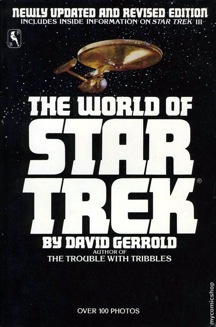Like a lot of people, I came to science fiction via Star Trek. But I also owe Trek for showing me how to write. Or rather, more specifically, I owe David Gerrold and his book The World of Star Trek for teaching me how to think about stories.
Gerrold’s book—I owned the original 1973 paperback until it fell apart, then upgraded to the 1984 revised edition shown above—was one of the few books available during the dead years between the end of the original series and the first movie in 1979. Along with Stephen Whitfield and Gene Roddenberry’s The Making of Star Trek, this was the definitive source—for a kid living in the swamps of Tennessee in the seventies—for all things about the making of the original Star Trek. The Making of… described in detail how the series was developed, while the World of… contained in-depth interviews with most of the cast and crew.
But it was Part Four of The World of Star Trek, subtitled “The Unfulfilled Potential,” that taught me how a story should work.
In this section, Gerrold looks at the trends that developed during the series’s three seasons, dissecting what succeeded and what didn’t. He differentiates between legitimate stories and ones he calls “puzzle box” stories, where there’s a dilemma to be solved that has no real effect on the characters. He identifies the crucial difference between the network expectations (“Kirk in danger!”) and the series’s best tendencies (“Kirk has a decision to make”). He also points out the repeated theme of Kirk coming into a society, judging it and remaking it as he sees fit.
Some of his observations are both pithy and delightful. To describe how unpleasant Klingons are, he says they “fart in airlocks.” Of the convention of the heroine as hero’s reward, he says, “Of course she loved him—that was her job!” And he creates an hysterical “formula” Star Trek episode that is a pretty accurate catalog of everything the series did wrong.
But he also explained what Star Trek did well, and why it worked. His analysis of “The City on the Edge of Forever” showed me why this is regarded as the series’s best episode, and in his list of other good stories, I began to see the trends. And then I began to understand.
At one point, after making suggestions should the show ever return, Gerrold says, “Maybe the guy who produces the next outer-space series will read this book….” I can’t speak to that, but I know I did, and it mattered. Without Mr. Gerrold’s book, I might never have become a writer, or at least never one who knew what the hell he was doing. By dissecting my favorite series, I learned there was a qualitative difference between a story like “The Doomsday Machine” (my favorite episode) and “The Lights of Zetar.” I understood why that difference mattered. And when I began telling my own stories, I tried to go back to these rules and make sure I crafted only “good episodes.”
Alex Bledsoe, author of the Eddie LaCrosse novels (The Sword-Edged Blonde, Burn Me Deadly, and the forthcoming Dark Jenny), the novels of the Memphis vampires (Blood Groove and The Girls with Games of Blood) and the first Tufa novel, the forthcoming The Hum and the Shiver.










